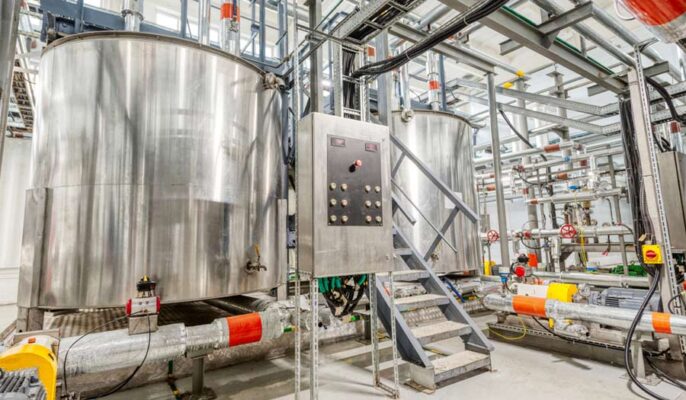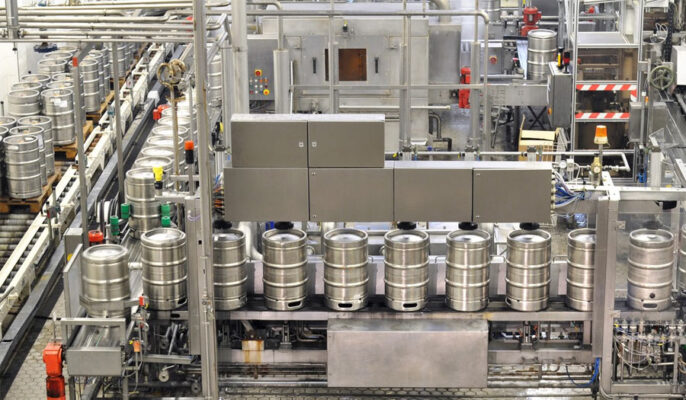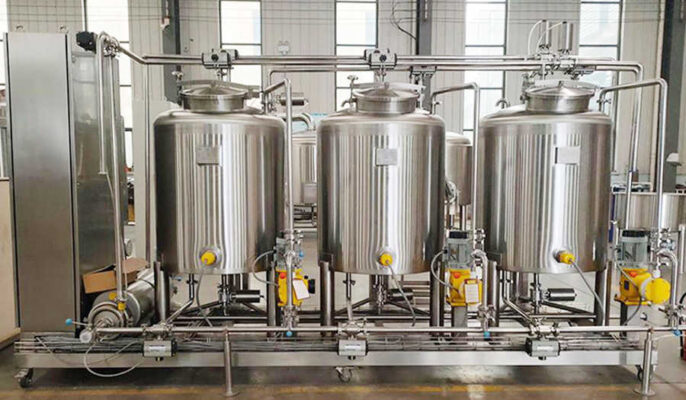Homebrewing and craft brewing have seen a huge surge in popularity in recent years. With so many new hobbyists and microbreweries entering the market, the range of brewing equipment available has expanded dramatically. This guide will explore the various types of equipment needed for craft beer production, from kettles and fermenters to kegging systems and filtration units. We’ll break down the key choices, considerations, and costs for setting up your brewhouse.
Overview of Craft Beer Brewing Equipment
The basic brewing process involves mashing grains, boiling wort, fermenting, conditioning, filtering, and packaging. While it’s possible to produce beer with very simple equipment, most craft breweries use more specialized gear to improve efficiency, quality, and capacity. Here’s an overview of the typical equipment needed:
| Brewing Equipment Type | Key Function | Entry Level Options | Advanced Options |
|---|---|---|---|
| Mash tun / Lauter tun | Mixes crushed grains with hot water for mash conversion and wort separation | Cooler mashtun with braided hose | Stainless mash tun with false bottom |
| Brew kettle | Heats wort, facilitates boiling and hop additions | 5-10 gallon brew kettle | 15-30 barrel commercial brewhouse |
| Wort chiller | Quickly cools boiled wort before fermentation | Immersion chiller coil | Plate chiller, heat exchanger |
| Fermenter | Holds beer during primary and secondary fermentation | Plastic bucket, glass carboy | Conical stainless unitank |
| Temperature control | Maintains optimal fermentation temperature | Fermwrap heater, cool bottle | Glycol chiller system, heat exchanger |
| Yeast management | Cultivates yeast for fermentation pitch | Mason jars, stir plate | Yeast brink, conical propagator |
| Transfer equipment | Moves liquids between vessels | Auto-siphon, tubing, pump | Automatic inline transfer |
| Filtration | Clarifies and stabilizes finished beer | None, settling in fermenter | Plate filter, centrifugation |
| Carbonation | Adds CO2 bubbles to beer before serving | Priming sugar, cask conditioning | Force carbonation in keg or brite tank |
| Serving vessels | Dispenses carbonated beer to drinkers | Bottles, kegs, casks | Canning line, bottling line |
This covers the standard brewing hardware for small to medium sized breweries. Larger industrial setups will also incorporate conveyors, automated sensors, CIP systems, and other specialized gear. Understanding the options for each process will help craft the ideal brewhouse within budget.
Mash Tun / Lauter Tun Options
The mash tun mixes the crushed malt with hot water to activate mash enzymes and convert starches into fermentable sugars. The lauter tun then separates the sugary wort from the grain particulates. For homebrewers, this is often done in a single vessel like an insulated picnic cooler. Commercial breweries generally use dedicated mash and lauter tuns.
Mash Tun Considerations
- Volume – Size in gallons or barrels to accommodate max batch size
- Direct vs indirect heat – Steam jackets vs external heating of water
- Insulation – Reduce heat loss during mashing rest times
- False bottom – Perforated or slotted screen for wort filtration
- Rakes – Mix mash and improve filtration efficiency
- Automation – Computerized temperature and viscosity sensors
| Type | Description | Capacity | Cost |
|---|---|---|---|
| Cooler mashtun | Insulated beverage cooler with braided hose for filtering | 5-10 gallon batches | $50-$150 |
| Stainless mash tun | Fabricated stainless steel mash tun with false bottom | 10-20 barrel brewhouse | $5,000-$10,000 |
| Jacketed mash tun | Steam-heated commercial mash tun | 15-30 barrel system | $15,000-$25,000 |
Homebrewers can often repurpose a drink cooler as a combined mash/lauter tun on a budget under $100. Commercial mash tuns require heavy duty stainless construction and false bottoms for wort filtration. Automated rakes and computer controls further increase costs in large brewhouses.

Brew Kettles for Boiling Wort
After lautering, the sweet wort moves to the brew kettle for boiling. This accomplishes several things:
- Sterilization – Boiling kills bacteria for sanitation
- Hop Isomerization – Adds bitterness and flavor from hops
- Extraction – Dissolves sugars, proteins and compounds from hops
- Evaporation – Concentrates wort to desired gravity and volume
Many options exist for wort boiling vessels:
| Type | Volume | Heat Source | Cost |
|---|---|---|---|
| Stainless steel brew kettle | 5-30 gallon | Propane burner | $100-$500 |
| Electric brew kettle | 5-15 gallon | Embedded electric elements | $150-$500 |
| Steam jacketed kettle | 7-30 barrel | Steam jacket | $5,000-$25,000 |
| Direct fire brewhouse | 10-100 barrel | Gas burner array | $50,000-$500,000 |
For homebrewing, basic stainless kettles in the 5-10 gallon range work well for stovetop boiling. Commercial kettles use steam jackets, natural gas burners, or electric elements to generate the heat needed for larger batch sizes. Sophisticated computer automation is also common. Costs scale dramatically with production capacity.
Wort Chillers for Rapid Cooling
Once boiled, the hot wort must be quickly cooled to under 100°F to pitch yeast. Slow cooling risks contamination and poor fermentation. Brewers use wort chillers to optimize this temperature reduction.
| Cooling Method | How It Works | Speed | Cost |
|---|---|---|---|
| Ice bath | Submerge kettle in ice water bath | Slow, 1+ hrs | Cheap, ice |
| Immersion chiller | Coil in kettle cooled by flow of cold water | Medium, 30 min | $50-$100 |
| Plate chiller | Flow wort across plates surrounded by cold water | Very fast, 5 min | $150-$300 |
| Heat exchanger | Pass wort through tubes surrounded by cold liquid | Extremely fast, 1 min | $1,500+ |
For 5 gallon batches, an immersion chiller coil works well and is inexpensive. Larger commercial heat exchangers or plate chillers provide rapid cooling. Glycol chillers are also popular for precise temperature control.
Fermentation Vessels: Carboys, Buckets, Unitanks
Once chilled, the wort is transferred to a fermentation vessel where yeast converts sugars into alcohol and CO2. Many fermenter options exist:
| Type | Volume | Material | Cost |
|---|---|---|---|
| Glass carboy | 3-6 gallons | Glass | $20-$50 |
| Plastic bucket | 3-6 gallons | Food-grade plastic | $10-$20 |
| Stainless conical | 7-60 barrel | Stainless steel | $1,000-$5,000 |
| Open fermentor | 5-30 barrel | Stainless or wood | $500-$2,000 |
Homebrewers often use inexpensive carboys and buckets in the 5 gallon range. Commercial breweries use large stainless steel unitank fermenters with conical bottoms for collecting yeast and dry hop additions. Open wood or stainless fermentors are also popular for specific beer styles.
Temperature Control Systems
Controlling fermentation temperature is critical for clean, consistent beer. The optimal range for most ales is 60-72°F. Lagers ferment even colder, around 45-55°F. Options for temperature control include:
| Type | Method | Precision | Cost |
|---|---|---|---|
| Swamp cooler | Evaporative cooling via wet shirt or towel | ± 4-5°F | Cheap |
| Fermwrap heater | Heating pad wraps fermenter | ± 2°F | $30-$50 |
| Glycol chiller | Recirculate cooled glycol liquid | ± 1°F | $300-$1,000 |
| Jacketed unitank | Integrated cooling jacket | ± 1°F | $1,000-$5,000+ |
The glycol chiller systems used by professional breweries allow precise temperature control, but are expensive. Homebrewers can often manage with cheaper fermwrap heaters or swamp cooler setups.
Yeast Management Equipment
Reusing a healthy yeast culture speeds fermentation and provides consistency between batches. Equipment like stir plates and yeast brinks help maintain cultures.
| Item | Purpose | Cost |
|---|---|---|
| Mason jar | Store yeast cakes for harvesting | $1 |
| Erlenmeyer flask | Grow yeast starters on stir plate | $5-$10 |
| Stir plate | Agitate yeast starter for growth | $50-$150 |
| Yeast brink | Maintain active cultures for pitching | $1,000-$2,000 |
For homebrewing, mason jars and flasks work well for reusing yeast and making starters. Commercial brewers use yeast brinks for large volume storage and management of multiple strains.
Transfer Equipment: Pumps, Tubing, Racking Canes
Sanitary transfers from fermenters to aging tanks, packaging, and more require various tubing, piping, valves and pumps:
| Item | Material | Purpose | Cost |
|---|---|---|---|
| Auto-siphon | Plastic | Homebrew transfers | $10-$20 |
| Tubing | Vinyl, silicone, stainless | Short runs of wort/beer | $0.50-$2/ft |
| Quick disconnects | Stainless, plastic | Disconnect tubing easily | $3-$10 ea |
| Pump | Stainless steel | Transfer liquids | $100-$1,000 |
| Inline filter | Plastic, stainless | Clarify transfers | $20-$150 |
Food grade vinyl or silicone tubing works for small transfers. Stainless steel piping is used for hard plumbed commercial systems, along with quick disconnect fittings for assembly. Peristaltic and centrifugal pumps efficiently move beer between vessels.
Beer Filtration Systems
Filtering finished beer helps clarify appearance and enhance stability:
| Type | Method | Scale | Cost |
|---|---|---|---|
| Gelatin fining | Gelatin powder binds haze particles for settling | Homebrew, 1-5 barrels | $20 per batch |
| Diatomaceous earth | Filter aid forms porous cake to filter beer | Pilot system, 1-7 barrels | $100-$300 |
| Plate and frame filter | Beer forced through stacked plates by pressure | Mid-size brewery, 5-30 barrels | $4,000-$8,000 |
| Centrifuge | Spin beer at high speed to separate solids | Large brewery, 30+ barrels | $30,000-$60,000+ |
Simple gelatin fining works well for homebrew scale if beer is given time to settle out in the fermenter. Commercial breweries use either plate filters or centrifuges for clarity and stability.
Carbonation and Serving
The final steps of production involve adding carbonation and serving the beer:
| Method | How It Works | Scale | Cost |
|---|---|---|---|
| Priming sugar | Added to fermenter, yeast produce natural CO2 | Homebrew, kegs, cask | Minimal |
| Cask conditioning | Secondary fermentation in cask | Firkins, pins | $100-$500 per cask |
| Force carbonation | Inject CO2 into kegs, tanks, brite beer | Draft and bottling systems | $500-$5,000 |
| Counter pressure filler | Maintains CO2 during bottling | Bottling line | $2,000-$10,000 |
Homebrewers and cask ale pubs rely on priming sugar for natural carbonation. Larger breweries force carbonate everything from kegs to bottles. Specialized counter pressure fillers maintain carbonation levels for bottling draft beer.

Choosing Brewing System Suppliers
Many factors go into selecting equipment vendors and designing a brewhouse. Here are key considerations when sourcing a professional brewing system:
- Reputation and experience – How long have they been in business? Check references.
- Quality of fabrication – Build quality, material choice, sanitation.
- Customization – Ability to accommodate specific needs.
- Customer service – Responsive support. Availability of parts/service.
- Scale options – Systems sized for needs today and growth plans.
- Pricing/value – Competitive pricing for quality and features.
- Lead time – Ability to deliver within project timeline.
- Manual vs automated – Level of control system integration needed.
Thorough upfront planning and vendor selection helps ensure a productive, efficient, and scalable brewing system that will support business goals.
Pros and Cons of Brewing Equipment Choices
Deciding on the right equipment configuration depends on budget, production goals, and growth plans. Here’s a look at the advantages and limitations of key options:
| Equipment | Pros | Cons |
|---|---|---|
| Cooler mashtun | Inexpensive, easy | Limited efficiency and batches |
| Gas fired kettle | Powerful, fast boiling | Venting challenges, energy costs |
| Electric kettle | Clean, convenient | Upfront cost, slow ramp up |
| Plate chiller | Rapid chilling | Expensive, space |
| Conical fermenter | Yeast collection, dry hopping | Cost, equipment footprint |
| Glycol chiller | Precise control | Complex, high cost |
| Centrifuge | Fast, clear beer | Very expensive, delicate |
Balancing factors like cost, quality, consistency, and capacity help guide equipment decisions for a brewhouse. Focus on the functionality needed to meet quality and production goals both now and for projected growth.
Equipment Cost Analysis
Brewing equipment represents a major startup and capital investment. Expect costs from $1,000 to over $1 million depending on system scale and features. Here are typical price ranges:
| System | Key Components | Typical Cost Range |
|---|---|---|
| 1 barrel pilot system | 3 vessel brew kettle, fermenters, glycol chiller, kegging | $15,000-$30,000 |
| 3-7 barrel microbrewery | 3-7 barrel kettle, 5-15 barrel fermentation, glycol, filtration, keg/canning | $75,000-$250,000 |
| 15 barrel production brewery | 15 barrel kettle, 30 barrel fermenters, centrifuge, canning | $500,000-$1.5 million |
| 30 barrel regional brewery | 30-60 barrel kettle, 120 barrel fermenters, bottling | $1.5-$5 million |
Economies of scale allow larger breweries to produce beer at lower equipment costs per barrel. However, quality ingredients, technique and passion remain key!

FAQs
Q: What are the essential items for a basic homebrew system?
A: For basic homebrewing, you need a brew kettle, fermenting bucket, siphon and tubing, sanitizer, airlock, thermometer, bottles, and ingredients. Start with our homebrewing startup guide.
Q: What size brewing system do I need for a microbrewery?
A: For a microbrewery, look at 1-3 barrel brewhouses up to 10-15 barrels. This covers tapping 1-3 kegs at a time for a taproom up to broader distribution.
Q: Is buying used brewing equipment a good idea?
A: Used equipment can save money, but evaluate wear and sanitation carefully. Replace any items that are overly worn or rusted. Ensure electrical components meet current codes.
Q: How much does it cost to open a 10 barrel microbrewery?
A: With a 10 barrel brewhouse, 3 10-barrel fermenters, glycol chiller, brite tank, kegging and modest taproom buildout, plan on $250,000-$500,000.
Q: Should I choose stainless or copper brewing equipment?
A: Modern breweries strongly prefer stainless steel for durability and sanitation. Copper looks beautiful, but requires heavy maintenance. Go stainless for functionality.
Q: What qualifications should a brewery design consultant have?
A: Look for a consultant with at least 10-15 years of commercial brewing experience with system design, installation, and operation expertise. An engineering background is a plus.
Q: Can I build my own electric brewery control system?
A: While advanced homebrewers can construct electric kettles and controllers, commercial breweries are better served by integrated automation packages from reputable vendors. This reduces troubleshooting and risk.
Q: How often do breweries need to replace equipment?
A: With proper maintenance, major equipment like kettles, fermenters, chillers, and filtration can last 15-25 years. Expect to replace pumps, gaskets, and small parts more regularly.




